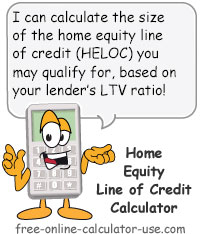IMPORTANT: Numeric entry fields must not contain dollar signs, percent signs, commas, spaces, etc. (only digits 0-9 and decimal points are allowed).
Click the Terms tab above for a more detailed description of each entry.
Step #1:
Enter the appraised value of your property.
Step #2:
Enter the total balance of all liens against the property.
Step #3:
Enter the loan to value ratio set by your lender.
Step #4:
Click the "Calculate LOC Amount" button.


Follow me on any of the social media sites below and be among the first to get a sneak peek at the newest and coolest calculators that are being added or updated each month.